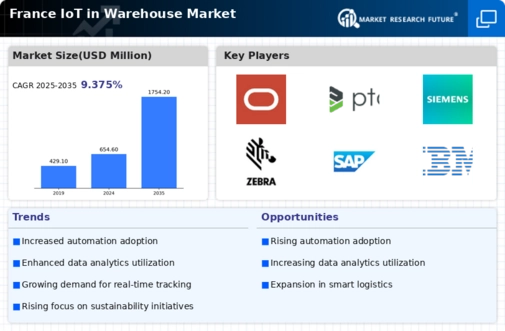The iot in-warehouse market in France is characterized by a dynamic competitive landscape, driven by technological advancements and increasing demand for operational efficiency. Key players such as Siemens (DE), Honeywell (US), and Cisco (US) are at the forefront, each adopting distinct strategies to enhance their market presence. Siemens (DE) focuses on innovation through its digital twin technology, which allows for real-time monitoring and optimization of warehouse operations. Honeywell (US), on the other hand, emphasizes partnerships with logistics firms to integrate its automation solutions, thereby enhancing supply chain visibility. Cisco (US) leverages its networking expertise to provide robust connectivity solutions, which are essential for the seamless operation of IoT devices in warehouses. Collectively, these strategies contribute to a competitive environment that is increasingly centered around technological integration and operational excellence.
In terms of business tactics, companies are localizing manufacturing and optimizing supply chains to respond swiftly to market demands. The competitive structure of the market appears moderately fragmented, with several players vying for market share. However, the influence of major companies is substantial, as they set benchmarks for innovation and operational efficiency that smaller firms strive to emulate.
In October 2025, Siemens (DE) announced the launch of its new IoT platform designed specifically for warehouse management, which integrates AI-driven analytics to enhance inventory accuracy and reduce operational costs. This strategic move is likely to position Siemens as a leader in the digital transformation of warehouse operations, enabling clients to achieve greater efficiency and responsiveness in their supply chains.
In September 2025, Honeywell (US) expanded its partnership with a leading logistics provider to implement advanced automation solutions across multiple distribution centers in France. This collaboration is expected to streamline operations and improve delivery times, reflecting Honeywell's commitment to enhancing supply chain agility through innovative technology. Such partnerships may also serve to solidify Honeywell's market position by demonstrating its capability to deliver tailored solutions that meet specific client needs.
In August 2025, Cisco (US) unveiled a new suite of IoT security solutions aimed at protecting warehouse networks from cyber threats. This initiative underscores the growing importance of cybersecurity in the IoT landscape, particularly as more devices become interconnected. By prioritizing security, Cisco not only enhances its product offerings but also addresses a critical concern for warehouse operators, thereby reinforcing its competitive edge.
As of November 2025, the competitive trends in the iot in-warehouse market are increasingly defined by digitalization, sustainability, and AI integration. Strategic alliances are playing a pivotal role in shaping the landscape, as companies collaborate to leverage complementary strengths. Looking ahead, it appears that competitive differentiation will evolve from traditional price-based competition to a focus on innovation, technology, and supply chain reliability. This shift suggests that companies that prioritize technological advancements and sustainable practices are likely to gain a competitive advantage in the future.























Leave a Comment